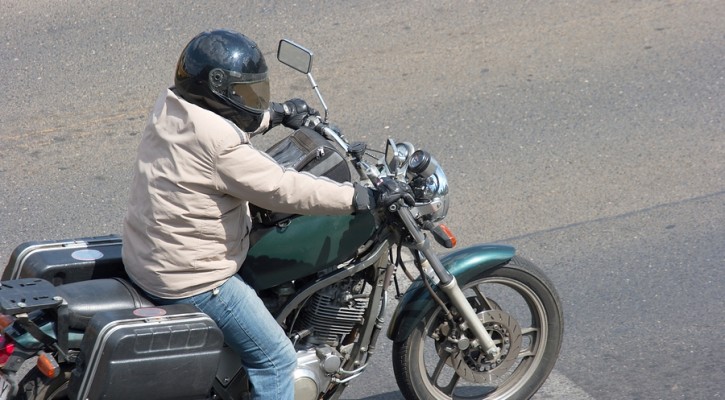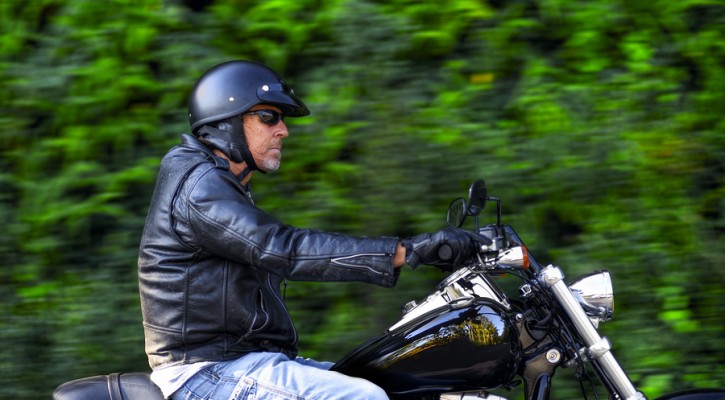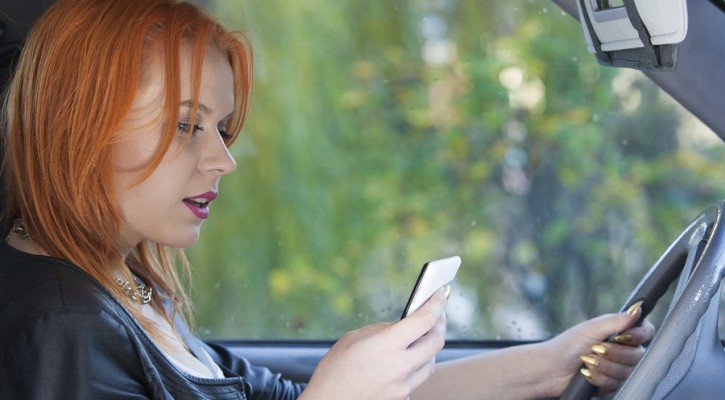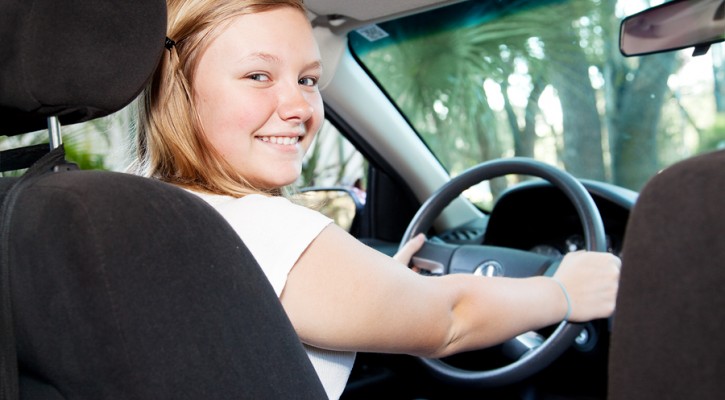
Motorcycle Awareness for the Clueless – Lesson 3
May 9, 2014
Lesson 3: Are their brake lights out?
Have you ever noticed that most motorcycles slow down with no visual warning (brake light)? You might have been in traffic, or pulled up to a stoplight, and wondered “Why didn’t that biker’s brake lights turn on? Are they busted?”.
More than likely, their brake lights work just fine, they just aren’t using their brakes. Most bikers avoid using their brakes when slowing down or approaching an intersection. Instead, they utilize a downshifting strategy to reduce speed, and therefore have no need for brakes or brake lights.
So, the next time you find yourself driving behind a motorcycle make sure you give them plenty of space. Since most drivers have been conditioned to respond to brake lights, it can more difficult to notice a biker’s deceleration without the bright red lights there as a warning.

Motorcycle Awareness for the Clueless – Lesson 1
May 7, 2014
Lesson 1: Why is that scary biker honking at me?
One day, you were driving down the road, minding your own business, when suddenly you heard a motorcycle engine roar, a horn honk, and looked over to see a leather-clad biker passing you with startling speed. At the time, you might have wondered, “Why is that scary biker honking at me?”
Well, first of all, the biker isn’t scary just because he/she is wearing leather. Tough leather jackets help protect motorcyclists from road rash in the event of a crash. But, to answer the initial question: most bikers honk at cars to let them know they are there. The motorcyclist may be trying to escape your blind spot, hence the honking and quick acceleration. Simple as that.
So, the next time you hear a honk and notice it is a motorcycle passing you by, politely share the road and give that conscientious biker a friendly wave.

Parental Spy Technology
April 29, 2014
A new breed of parental gadgets has hit the market: devices that enable parents to monitor their teen’s driving habits. This new technology can sense a car’s speed, rate of acceleration and deceleration, as well as use GPS to track location. However, the way parents use this technology could do more harm than good. NPR takes a look at the effects of this parental spying technology, discussing incredibly important aspects of the dilemma. See the full story here:

The Price of that Text
April 28, 2014
It would seem that drivers have a serious texting addiction these days. The public outcry for safety has gone unnoticed by most text-obsessed drivers. They pass by anti-texting billboards and highway signs completely unaware because their eyes are glued to the glowing screens of their cell phones. Normally, I just try to get around these reckless drivers as quickly and safely as possible, but when one almost hits my car I will honk at them… only to be ignored because my fear of collision is less urgent than their social life.
Well, if drivers aren’t worried about their safety, or the safety of people around them, maybe they will take notice when slapped with a hefty traffic ticket. That would certainly make it harder to pay their cell phone bill. This is exactly what many states are hoping for, with all but 4 states joining the fight against texting while driving by charging offenders with penalties. Fines range from $20 (in California) to $10,000 (in Alaska), with an average of about $100.
A state-by-state map of texting while driving penalties can be found here.
Distraction Checklist
April 21, 2014
Don’t become another teen statistic or adolescent cliche by driving while distracted. Car crashes are the leading cause of death for young people, and multi-tasking while behind the wheel is a big contributor to teen driver crashes. So, keep that compulsive behavior in check by reviewing this common list of driving distractions.
1. Music. Find your station, CD, or MP3 playlist before leaving the driveway and never take your eyes off the road for your audio-obsession. You can always change the station at a stoplight if necessary.
2. Friends. Having other people in the car drastically increases a teen’s crash risk. So, don’t let your friends become a distraction or force for peer pressure. Drive the same way you would with parents or a driving instructor.
3. Food. Eating in the car is never a good idea. In fact, fast food in general is pretty terrible. Save yourself the calories, acne, and stomach ache by eating real food at a real restaurant.
4. Phone. Just put that phone in the back seat and forget about it. Texting and talking on the phone are a serious distraction for people of all ages.
Hands-Free is not Risk-Free
April 14, 2014
Learn why cell phone use is dangerous even if it’s on a hands-free device. The Teen Safe Driving blog has the full story here:
http://teensafedriving.org/blog/hands-free-is-not-risk-free/
Lane Change Etiquette
April 14, 2014
If you want to change lanes in traffic, you need to know how to do it correctly. Official laws concerning lane changes can vary from state to state, but for the most part, police will readily pull over any driver that changes lanes in a dangerous manner. For this reason, it’s best to learn all the nuances of lane-changing etiquette.
Never change lanes in a blind spot. This is especially important when changing lanes next to larger trucks and 18-wheelers. Instead, try to change lanes before you hit their blind spot, or continue in your own lane until you pass their blind spot. Remember, if you can’t see their mirrors then they can’t see you.
Always check your blind spot. After checking your mirrors and making sure your vehicle is a safe distance from those ahead of you, take a quick glance over your shoulder to check your blind spot before changing lanes.
Use your blinkers. They are there to warn other drivers of the direction you intend to go. Police are always on the lookout for drivers weaving between lanes without blinkers, making the highways more dangerous for everyone around.
Don’t tailgate. There is no reason to tailgate a vehicle before switching lanes to pass them. It’s not smart, it’s certainly not safe, and you can actually get ticketed for it. If you notice that the driver ahead of you is moving at a slower pace, then prepare to switch lanes before you are riding their bumper.
Don’t cutoff other vehicles. This is an offense that puts people’s lives in danger, and if an officer sees you cutting off another driver they will ticket you for either a) reckless driving, b) unsafe lane change, or c) aggressive driving. These can be serious offenses, which result in a greater number of marks on your record and higher insurance rates.
Don’t linger in the fast lane after passing a vehicle. If you have changed lanes to pass another vehicle, then move back over after you can see both of their headlights in your rearview mirror. This allows other vehicles to use the fast lane for passing, aiding in traffic flow and making the highway safer for all drivers. Plus, many states have made it illegal to obstruct traffic by cruising in the left lane.
Following these rules of the road will not only make you a safer driver, but also a smarter and more courteous driver, which makes the roads safer and more pleasant for everyone involved.
10 Things You Don’t Know About Teen Drivers
April 13, 2014
There are a lot of risks to face out there on the open road, especially as a new driver. However, knowing a few facts and numbers can help both parents and teens to be more cautious and make safer decisions behind the wheel. Here are 10 things you probably did not know about teen drivers:
1. The first twelve months of driving are the most dangerous time in a teenager’s life.
2. Even after the first year, and after teens turn into 20-somethings, the risk of a crash remains extremely high. For this reason, the road can remain a dangerous place, and auto insurance rates will remain high as well. In fact, the risk of being a young driver doesn’t significantly decrease until the age of 25.
3. Teens don’t always take more risks than other drivers. In fact, the most common reason for teen crashes is inexperience rather than risky behavior.
4. Teen drivers are 3X more likely to crash than experienced drivers.
5. Three or more passengers increase a teen drivers crash risk by 4X.
6. Most fatal nighttime crashes happen before midnight.
7. More than 50% of teens killed in car crashes were not wearing a seatbelt.
8. Most states have inadequate teen driving laws and restrictions to protect teens from common crash risks.
9. Teens get their driving habits from their parents.
10. Among other gender differences, teen boys are 3X more likely to drive aggressively when there’s a girl in the car.
Downtown Driving Tips
April 12, 2014
A drive through downtown takes a certain presence-of-mind and careful nuance. There are tons of people, either on foot, bicycle, unicycle or skateboard, and they are all there to enjoy the downtown life. Therefore, safety is not on the top of their to-do lists. As a driver, it is your responsibility to share the road and avoid hitting all the people in your path. Here are a few tips to help guide you through the chaos of a downtown drive:
Slow your roll. By driving slow, you will be able to react in time and avoid running people over. Also, the chances of a person getting hit by a car dying is directly related to speed: 90% chance of death at 55 mph, 50% chance of death at 40 mph, and a 10% chance of death at 25 mph.
Yield the right-of-way to those walking. Always. Even if you think you’re right, it doesn’t matter. Pedestrians always have the right of way. After all, you can’t just run them over.
Take left turns carefully. This is a common mistake among downtown drivers, and can end in a serious injury. Always look for pedestrians when taking a left turn, because more than likely, the walk signal will be indicating it’s their turn to cross the street. Just like you are supposed to yield to oncoming traffic, you must also yield to oncoming pedestrians.
Look twice before taking a right on red. Yes, you can turn right if the light is red. However, first check to make sure no one is crossing the street.

Choosing the Right Teen Driving School
April 12, 2014
When on the hunt for a good teen driving school, there are many factors to consider. This post written over at fourhensandarooster.com talks about one driving school that has it all: excellent student-teacher ratios, lots of time behind the wheel, good instructors, vehicle maintenance lessons and even a class for the parents. Plus, it takes place at a race track! We should all be so lucky. See the full story here:
http://fourhensandarooster.com/teen-driving-solutions-school-must-teen-drivers/
